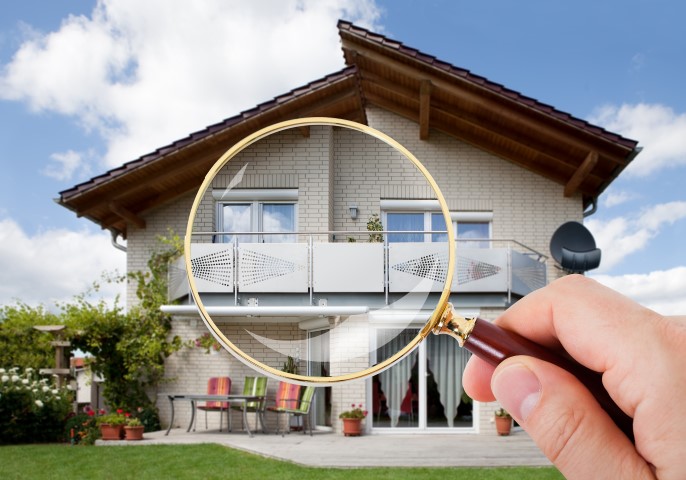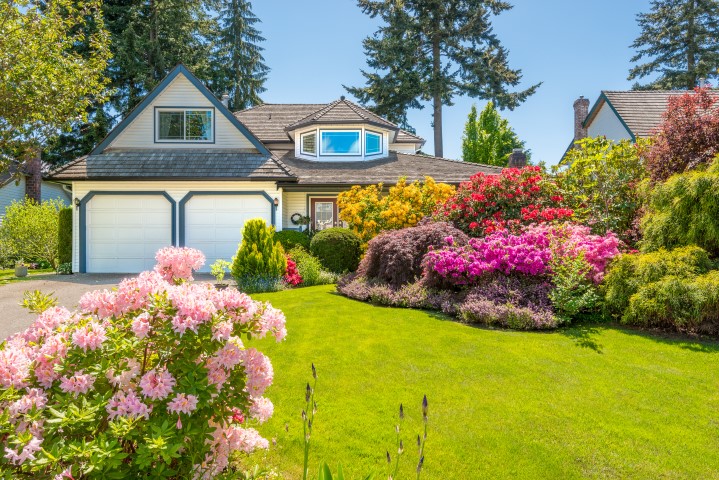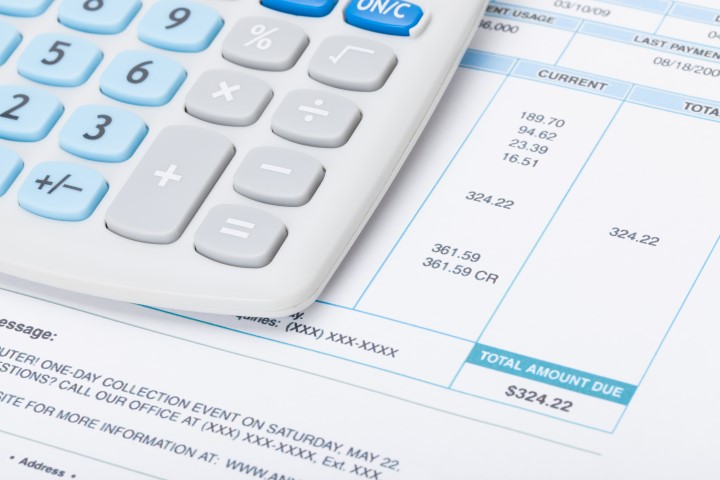|
So you’ve decided the exterior of your house needs to be repainted. Whether this is a project to improve the curb appeal of your home for resale, or you want to improve the aesthetics of the place where you live, consider repainting the exterior as an investment in the value of your house.
Faced with the mountain of choices for color, paint style, whether to do it yourself; the decision to repaint can be daunting. Here are some tips: Keep it simple. When people see all the colors available they sometimes get carried away. Consider your house paint like an artist sees a blank canvas. You can add color in shrubs and flowers. Don’t make your house the neighbors refer to as “the ugly blue raised ranch”. Avoid highlighting things like eaves troughs, gutter spouts, and garage doors by painting them a contrasting color. They should blend in not stick out like a sore thumb. Give thought to what surrounds your house. Large shade trees, porches, shrubs tend to make a house look darker. Go with lighter exterior paint. Think about the color of shingles, walkways, other materials like brick and stone trim or driveway. Make the color you choose blend with these. If you have an interesting architectural detail like trim, a widow’s walk, a weather vane, gargoyles, a verandah that you want to highlight, consider using contrasting color or a darker or lighter shade of the same color on these. Consider the size of your lot. If you have a large lot and a small house, go with white, off white or a lighter color. On the other hand, if you have a large house on a small lot, darker color will make your house appear smaller but substantial. White and off white were always considered safe choices. Today people are going with tints or shades of greys, browns, greens, and blues because these complement the landscaping and other house materials. Before you decide on a color use an app to see what it will look like on your house. These apps can be downloaded to your smart phone or you can use a program available at most paint stores. Do it yourself or to hire a painter? This is a big, costly, time-consuming job requiring specialized equipment and heights! Unless painting is your profession.
0 Comments
Are your kitchen cupboards a hodgepodge of items you haven’t used in a year? Are the can goods mixed in with boxes of chocolate pudding? Do you have to search for the items you want? Is the counter littered with small appliances and cooking utensils?
If this describes your kitchen then perhaps it is time to declutter. Before you begin, get your mind and your kitchen ready for a big clean up. Clear the countertops. Empty the dishwasher. Fill your sink with hot soapy water ready to make long-unused glassware, pans, and dishes sparkle before putting them back in the cupboard. For decluttering, use a three-box method of sorting: Box #1: things I am still using. These will go back into the cupboard in an organized manner after I have scrubbed and/or relined the shelves with adhesive shelf paper available at any dollar store. Box #2: things that are still good and not past their expiration dates. These can be donated to a food bank or soup kitchen, as I do not use them anymore. Box #3: past their expiration dates, these items are destined for the garbage. The same goes for small appliances, pots and pans, dishes, glassware, and wall decorations. Donate or store under the counter. Get the clutter off the counters. Next, attack those drawers of cutlery and old recipe books. Use the three box method on them. Be relentless. If you haven’t used it in a year, out it goes. You don’t need five can openers and three corkscrews. Keep the good one and throw out or donate the others. An efficient kitchen is one that is pared to the bone. Those expired coupons and seldom-used cookbooks have to go out with the bag of catsup and mustard packets. Pace yourself. Do a cupboard a day or a drawer a day rather than rushing through your kitchen de-cluttering. Don’t forget those appliances. Use the three box method on the contents of your fridge. Scour shelves and make your fridge and stove sparkle inside and out. Next attack that “junk drawer”. We all have one! Resist the urge to keep something because you “might need it someday.” Organize what you do keep in a plastic tray. Is this a one-day job? For some it is. For others, slow and steady a section at a time is the way to go. It all depends on your energy, your available time, and your personality. The excitement of purchasing a brand new home can often be overshadowed by the time and stress of having to make hundreds of decisions and oversee the work as the new house develops. Many people opt not to build nor to live in a neighborhood where new homes are under construction.
Sometimes prospective homeowners fall in love with an established community or features of an existing home. Purchasing an existing home requires careful research. Prospective homeowners need to be ready to put the time into doing a thorough assessment of the home or homes they are considering for purchase. If the house is not relatively new, purchasers need to think about the climate of the area and the thermal heating and cooling efficiency, the condition of the structure, roof, exterior and interior needed improvements. Other considerations include the state of the landscaping and how much maintenance and replacement will need to be done. How well your purchase will hold its value in the real estate market where it is located is also a factor. Ask yourself whether you and your family will be comfortable in this existing home. Can you afford the mortgage, taxes, maintenance, future home improvements, and upkeep on this house? If this is a “fixer-upper” make sure you have budgeted for the things that need to be replaced. Consider repairs in stages from needed immediately, to nice…but. These considerations should include renovations, repairs, maintenance, and rebuilds; retrofitting things like kitchen or bathroom; upgrades to appliances or water systems, wiring and/or plumbing. Before you make the final decision to purchase an existing home, have professionals come in to do an assessment of wiring, plumbing, water, and structure of the building. A thorough pre-purchase evaluation is an absolute must. This is not an area to economize. Spend the money to hire an experienced, professional home appraiser who is knowledgeable about identifying the home’s hidden problems. Have this consultant advise you about the costs involved in rectifying problems or renovating. Or refuse to purchase until the present owner has fixed these problems to your evaluator’s satisfaction. Make sure you get a guarantee in writing that any emergency work for a specified time period will be at the cost of the present owner who has guaranteed these things. Once you have purchased, you will want to start on the wish list you created when you first looked at this dream home. Your realtor can be a good source of information about renovations and local tradespeople. One of a prospective buyer’s first impressions of a home or business is the front yard. An attractive front yard can greatly increase the selling price of a property. Even if you are not selling your home or business you want neighbors and visitors to have a good impression of where you live or work.
What things make a good impression? A healthy, well cared for lawn. If your lawn is kept mowed and free of weeds it creates a good impression. You can do this yourself, have a lawn care service do it or have a sod company install your grass and then maintain the cutting, aeration, weed and feed program yourself. A healthy lawn is like the canvas an artist paints upon. It is a good start. Other ways to add curb appeal are things like a fountain or a sculpture or a flowerbed or other center of interest. Your driveway and walkway are also part of the overall effect of your front yard. Consider surface options like concrete, stamped concrete, interlocking brick, paving stones or crushed stone. Whatever surface you use should be easy maintenance and aesthetically pleasing when combined with your house or business. If you are adding lights, remember: Less is more. Don’t clutter your yard with decorations or lights. The same holds true for color. When choosing plants it is better to go with one color and to choose one which complements your house. Consider shrubs and flowers that are perennial and hardy to cut down on the cost and labor of planting annually. If your house or business rises above street level, consider adding elevated walks and/or steps, which give your building an added dimension and center of interest. Walkway or flower garden borders of edging shrubs or railroad ties or large stone add interest and give edges a finished look. The next area to consider is that front entrance way. It should look clean and inviting not cluttered or barren. Steps should be clear of pots or other objects. The plants, planters, and other objects used should blend with the colors and style of the front door. Adding curb appeal to your home or business can pay off in many ways—both financial and aesthetic. Renovations needn’t break the bank. Check out Internet and landscaping magazines for ideas. With the cost of electricity mounting, it pays to consider ways to cut that electric bill at your house. Of course you can go green installing solar panels or taking advantage of wind power. But these things—while eventually saving you on your electric bill—have a staggering initial outlay. You can also turn the thermostat so the air conditioning doesn’t click on until the temperatures hit 85 in the summer. This will cut electric bills but may affect the quality of your life.
There are other ways to cut your home electric bill that aren’t so extreme. One simple way is to clean or replace those filters in your HVAC system at least twice a year. Air filters are cheap compared to electrical bills. Another easy and cheap way to conserve electricity is to keep your vents clean. Also check to make sure the vents are open. This will keep your furnace and air conditioner from struggling to keep your house at a constant temperature. It is a myth that closing vents can reduce energy costs. This will actually raise your electric bill. Use fans to improve the air flow in your house. These may be overhead fans or portable fans. Here’s how they work: When the air circulates optimally, it makes it easier for your HVAC system to heat or cool. Hence it does not have to struggle and consequently your electric bills are lower. If you have ceiling fans, when it is hot outside, have them turn counter clockwise. This pushes hot air up and out. In colder weather have them spin clockwise. This traps hot air inside. Check to see where the switch is on your ceiling fans so you can choose rotation direction . When you are doing laundry use cold or warm water instead of hot. Heating water in your washer accounts for 90% of the electrical cost of doing a wash. Do not over or under pack the washer. The ideal laundry load should contain as many articles as possible. However, stuffing your washer isn’t efficient either. There should be enough room for movement. Consider installing a clothesline to cut dryer costs. Don’t stuff your dryer. While the heat required to dry clothes is costly there should be room for movement. If not, the hot air won’t be able to blow clothes dry. You may then have to run it twice. That is quite inefficient. Don’t automatically throw an article in the wash if you’ve used it once. Consider whether it needs washing. |
More articles:
August 2018
Categories |
|
Contact Kirsten to get started today.
(310) 756-3524 [email protected] #DRE 01450452 Ask her about her newsletter to get current South Bay Market information and real estate news right to your inbox... no spammy ones, promise! |
|
Copyright © 2021 Kirsten Cole. All rights reserved.







 RSS Feed
RSS Feed
